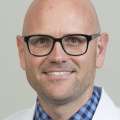UCLA’s pediatric critical care division at Mattel Children’s Hospital stands ready to address the most urgent and complex needs of a wide swath of young patients.
“We see the most critically ill children – from neonates to 21 years of age – needing the highest level of care. That involves anything from asthma and diabetes to organ transplant and open-heart surgery,” says Andreas Schwingshackl, MD, PhD, Associate Professor of pediatric critical care, and Chief of the Pediatric Critical Care division at Mattel Children’s Hospital.
Appointed in July, he heads a team of 15 faculty members, 10 pediatric critical care fellows and three staff members.
Dr. Schwingshackl, a native of northern Italy, graduated from Medical University of Innsbruck in Austria. Intrigued with the research there, he stayed an extra year in the Experimental Pathology department at the Austrian Academy of Biomedical Aging Research.
“Instead of immediately starting my clinical residency, I went to the University of Alberta, Canada, to pursue research and obtain a PhD in Physiology,” he says.
Afterward, he did a pediatrics residency at St. Joseph’s Hospital, Phoenix, followed by a pediatric critical care fellowship at UCLA from 2006 to 2009. His first job after training was at the University of Tennessee Health Science Center as an intensivist in the pediatric ICU. In 2015, he joined the faculty at UCLA.
Charged with care oversight for critically ill children, Dr. Schwingshackl says the demanding position requires professional flexibility.
“Critical Care is always exciting and interesting because no two days are ever the same. We don’t know what tomorrow brings,” he says, noting the division is aided by extensive professional support.
“We are fortunate at UCLA to be surrounded by subspecialists to help us in many specific areas. Then intensivists tie all that subspecialty information into one coherent treatment plan for any given patient.”
Goals and challenges
When considering objectives he holds for his division, Dr. Schwingshackl says the primary goal will always be excellent clinical care for critically ill children.
“We’re very good at that. But medicine moves quickly; it changes daily. So, we must stay on top of the progress,” he says. “Everything we do at the bedside today is so highly technical. All our tests are molecular; if we don’t keep up with the research, we won’t know which tests should be ordered to answer a specific question, and we won’t understand the test results.”

Dr. Schwingshackl would like to improve his division’s academic outputs and national visibility as a UCLA critical care center.
“That means increased presence at clinical and scientific conferences, and bringing more national clinical trials involving children to UCLA,” he says.
He also hopes to put greater emphasis on career mentorship, not just for trainees, but also for faculty.
“People who are mid- or late-career should have the same access to resources and faculty development as our junior faculty and trainees do,” he stresses. “People need to continue growing until the day they retire.”
Another challenge Dr. Schwingshackl recognizes, though it’s not necessarily UCLA specific, is the difficulty in promoting research among clinical trainees and faculty in clinically revenue-driven and clinically incentivized environments.
“Understandably, clinicians do more clinical work because of better compensation,” explains Dr. Schwingshackl. “It’s difficult to sell them on the idea of academic work and research for which they’re not compensated or may even require a pay cut to do. That is a national trend that everybody struggles with throughout the U.S.
“But research is vital; we need to create generations of physicians who are equally skilled in research and clinical arenas.”
Community access
Dr. Schwingshackl proudly points out that UCLA is exemplary in providing extremely high-level care to all pediatrics patients.
He asserts that while high-level neonate and adult ICU care can be found in smaller community hospitals, equivalent care typically is not available for “in-between neonate and adult” pediatric patients with a greater range of health care needs.
“It’s difficult to create university hospital-equivalent care out in the community,” says Dr. Schwingshackl, noting the few professionals with wide age-range experience tend to work in big hospitals. “In response, we are making sure all kids in the community needing UCLA’s level of care get moved rapidly, efficiently and safely to the university hospital.
“We work hard on name recognition in the community so that hospitals, urgent cares centers and clinics have immediate access to our transfer center. We make sure we can reach outlying communities very rapidly to bring kids back to UCLA’s hospital facilities, whether by ambulance, helicopter or any means available.
“We also have three staff members at Los Robles Medical Center actively engaging with local pediatricians, ensuring they have immediate access to our transfer team when a child in their clinic needs a higher level of care. We are completely committed to making sure all young people get the care they need.”




